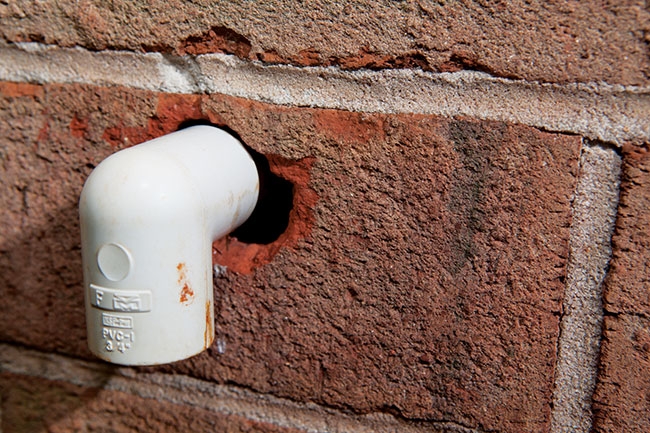
Pest Supplement: Structural deficiencies in poultry barns
By Alice Sinia Ph.D. Orkin Canada
Features Barn Management ProductionPrevent unwanted visitors from entering your facility.
 Small cracks and crevices provide the perfect opportunity for unwanted critters to enter your facility. PHOTO CREDIT: Orkin
Small cracks and crevices provide the perfect opportunity for unwanted critters to enter your facility. PHOTO CREDIT: OrkinCockroaches, ants, birds, ground beetles and rodents are exactly the kinds of visitors you do not want to stop by unannounced. Poultry facilities often have an abundant supply of food, water and shelter – the three resources pests need to survive. And any tiny cracks, gaps around utilities or tears in window screens could let pests in to your workplace.
Many insects and other pests have the ability to carry and transmit harmful bacteria, viruses and diseases to both people and poultry birds. To protect your poultry and employees from pest-transmitted pathogens and physical injuries caused by them, it is important to identify conducive conditions such as readily available food or water, potential entry points and habourage sites and then correct these deficiencies and other weak spots that may attract and let in any unwanted pests.
How pests get inside
Small cracks and crevices provide the perfect opportunity for unwanted critters to enter your facility. Pests like bird mites can easily enter cracks that are barely open, and gaps around existing utility and plumbing lines or missing wall bricks and blocks create openings big enough for pests like ground beetles, ants and cockroaches to enter the building. Even sewers can provide networks for cockroaches and sewer rats to find their way in. In fact, cockroaches can fit through cracks as small as a sixth of a centimetre wide, mice can fit through holes the size of a dime and rats can fit through holes the size of a quarter.
When it comes to the exterior of a building, there are a multitude of ways pests can come indoors, such as cracks, gaps and holes.
These deficiencies provide access points for critters. Openings on the roof can also serve as a key point of entry for rodents and birds, which love these open spaces.
How to spot problems
Train your staff on the signs of pest activity so they can be on the lookout as they perform their normal routine. Regularly inspect for signs of pest activity and immediately alert your pest management provider of any issues. Make sure to complete a thorough inspection when looking for any cracks or openings leading inside the building – any overlooked opening could turn into an open door for pests.
Here are a few tips to help identify structural deficiencies that can lead to pest problems:
Regularly inspect your roof and rooftop HVAC units for openings, which can serve as bird nesting and roosting sites.
Positive air pressure will push flying pests out the door. To test if your building has positive air pressure that will prevent insects from coming inside, hold a tissue in front of a cracked exterior door. If the tissue is blown away from the building, the room has positive air pressure. If it is sucked in, the room has negative air pressure that will pull pests inside.
Check interior walls regularly for cracks, crevices and dust build-ups on flat ledges above eye level. These cracks provide harbourge for bird mites, mealworms and other pest insects.
Maintain a stringent sanitation schedule. Be especially vigilant about bird holding rooms and feeding pens, as these areas are susceptible to droppings, food spills and other sanitation issues that can become pest hot spots.
Set up pest monitoring devices to detect pest activities for early intervention. Monitoring not only detects pest activity in advance but it also helps to pinpoint problem areas that have conducive conditions that need to be addressed.
How to address problems
If structural deficiencies are allowing pests inside, it’s important to make repairs. Here are a few preventive actions you can take:
Windows
Replace broken windows, torn window screens and caulk any cracks or gaps around each window of your facility. Ants outnumber humans 14,000 to one and sealing up these openings make it more difficult for these invaders to intrude on your building.
Doors and entryways
Replace door sweeps as needed to eliminate gaps created by everyday wear and tear. Install air curtains at entrances and replace torn door screens to discourage flying insects from coming inside. If possible, keep doors closed at all times and install vinyl strip doors to help further prevent pest entry. Make sure doors are closing properly and tightly, and if they are not, lubricate the hinges. If daylight can be seen from inside when the door is closed, it means that the door is not closing properly.
Building exterior
Trim tree branches so they don’t touch the exterior of the building. Although most mice and rodents prefer to live close to the ground, some species will live in abandoned bird or squirrel nests found in trees. Keeping surrounding trees trimmed and away from the facility prevents these critters from climbing inside.
Waste management
Be sure to discard waste in sewers that could prevent the sewers from draining and ensure a proper poultry waste management system is in place, as they may catch the attention of curious pests.
Print this page